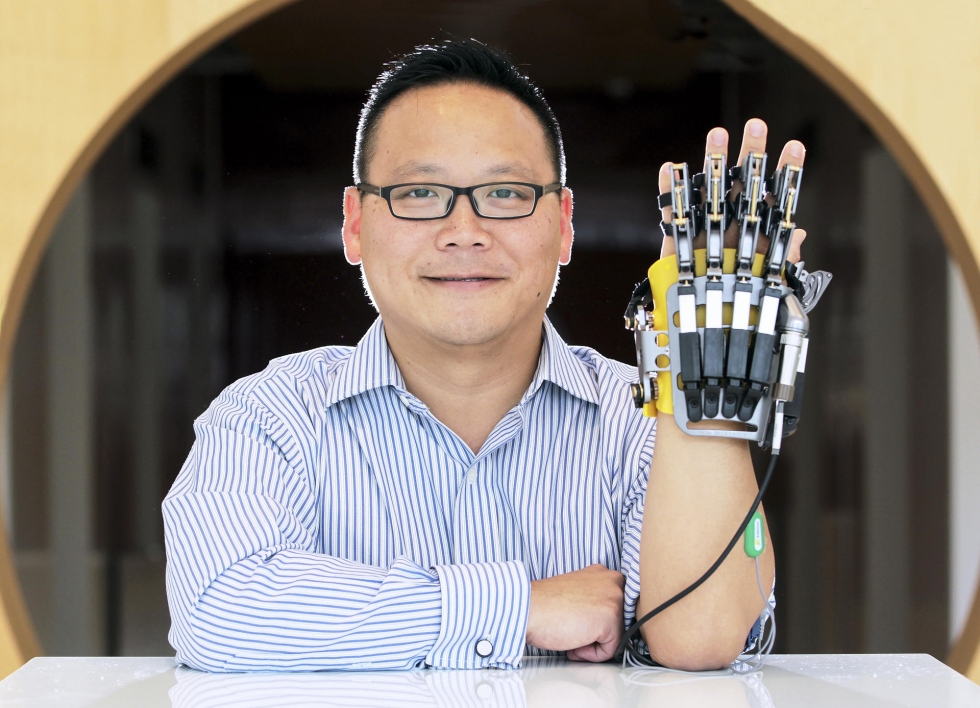Locally made robotic device helps stroke victims regain use of hands
2014-09-15

The Hand of Hope improves motor skills
I slip my left hand into the Hand of Hope - a metal casing on the back with straps that tighten around each finger. It's just like a scene from the Iron Manfilms.
Will I now achieve superhuman strength? Will I crush walnuts without a nutcracker? Sensors are attached to the muscles in my outer and inner forearm, and with a switch of a button, the robotic contraption clenches my left hand into a fist.
What happens next I find initially slightly spooky - it's a sense of mind over matter. I've been told by Michael Tsui Kam-fai of Rehab-Robotics not to move my hand. Instead, what I'm about to do is open my hand and stretch it by using my brain.
Actually, I'm not that good at it. Tsui's co-worker, Hazel Kwong, brings the level down a bit and on the big white screen the blue colour bouncing up and down on a graph is my - initially paltry - attempt to get my brain to open my hand. And then it happens. The robotic hand buzzes as it opens up and my hand is outstretched.
Tsui's Hand of Hope system brings hope to those who've suffered a stroke, sometimes ending up with one hand in a claw. Through repetitive movements, the hand helps the brain to rewire neurological pathways to the motor functions and make them relearn movement.
Typically, a stroke patient can make some basic movements with the upper parts of the arm but has little control over the hand. With the Hand of Hope, the device detects the tiny muscle impulses in the upper part of the arm as the patient tries to move a hand.
Tsui is the kind of all-rounder that is rare to find. At Polytechnic University he studied to become an occupational therapist, then later studied for a master of science degree in robotics and computer-aided engineering at Chinese University. He also has an MBA from Hull University in northern England.
Tsui worked together with PolyU to develop the hand. PolyU owns the original patent and Rehab-Robotics has developed a secondary model for commercial purposes. The technology for the hand is called "active assistive" or "intention driven".
"I've seen a lot of robots for lower limbs," says Tsui. "The muscles are bigger, so they are easier to detect."
Tsui compares the Hand of Hope to maths homework. "When you have a small child you can't do all their maths homework or the child won't develop. The way of learning for everything is that you provide just enough help when it is needed."
While there are, of course, rehabilitation services throughout Hong Kong, the importance of the hand is that it can be loaned to stroke patients, who can keep it semi-permanently in the home.
They're not just going for a session with a physiotherapist at the hospital twice a week, which Tsui feels is far from enough, but can practise their movements with the hand several times a day at home, and start seeing the progress for themselves.
With the hand also comes some software for games that can be viewed on a screen that teaches the brain how to move the muscles, and find different neurological pathways to do that. It's clever stuff, and provides a recovery opportunity for stroke patients that would have been unavailable to them just a few years ago. The science of motor relearning, says Tsui, has been around since the 1950s, when the potential was seen for neuro-regeneration, also known as neuro remapping.
How the Hand of Hope works is that it detects a patient's intentions. So if, in my mind, I want to move my fingers, the device will amplify these signals as many as 1,000 times before delivering them to the glove part of the device. Using the Hand of Hope, stroke survivors can pick up an egg or a glass with what is classed as their "bad" hand.
Made of a lightweight metal frame, the device has a feedback-based loop system that amplifies the brain's electrical signal and rewards the patient with the desired motion in concert with his or her muscular activation.
It's not cheap. "It costs €20,000 [HK$200,500] for a left and right pair," says Tsui, adding that two units have just been ordered by Ukraine.
The muscular movements of stroke survivors do improve with the Hand of Hope. "When the patient's brain is injured," says Tsui, "the control from your brain is lost," so the claw hand that develops is a protective mechanism.
"They will flex their muscles to protect their major organs. So it is a matter of getting stroke patients back to when they were newborns. It's a process of learning, but when the brain is injured then it is motor relearning. Every stroke patient will go through this protocol."
In 2012, at the International Exhibition of Inventions of Geneva, Rehab-Robotics was the first Hong Kong company to win the Grand Prix Award, with the Hand of Hope.
Because he was first an occupational therapist, Tsui says, "I have it from my gut," indicating his understanding for patients' needs.
Tsui is also busy working on other inventions. In another collaborative project with PolyU, they are looking to provide technology for patients with spinal injuries to be able to walk upstairs. There's also the wheelchair exerciser for wheelchair users, and the assistive training device for the whole forearm.
Rehab-Robotics has been nominated in the Innovation for Good Award category of the Spirit of Hong Kong Awards by Hong Kong Science and Technology Parks.
Source: South China Morning Post (Thursday, 11 September, 2014)


